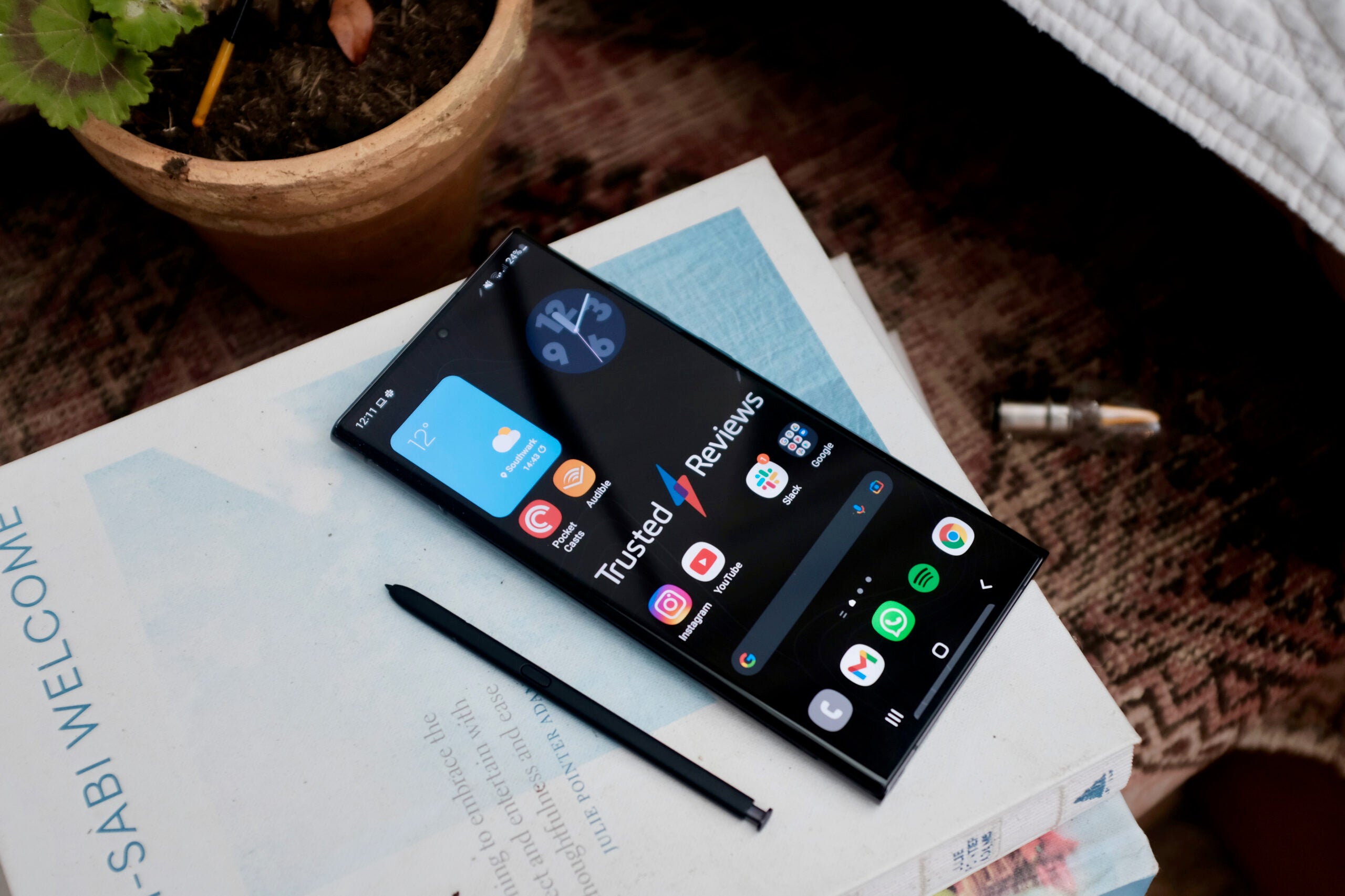Verdict
It may be a year old, but the Samsung Galaxy S22 Ultra is still a tempting phone with impressive capabilities in a rather large package. Most of it still works fantastically well, and importantly, it’s dropped in price since the release of the S23 Ultra.
Pros
- Stunning display with fantastic detail and brightness
- Versatile camera system with impressive zoom
- Good low-light camera performance
- Fast charging
- Promise of many years of updates
Cons
- Battery life should be better
- Design a step backward
- You need to buy the fast charger separately
Availability
- UKRRP: £1149
- USARRP: $1199.99
- EuropeRRP: €1259
-
Huge displayMassive 6.8-inch display with a 1440p resolution and seriously high brightness levels -
High-end specsExynos 2200, up to 12GB and 1TB storage -
S Pen includedThere’s an S Pen stylus included and it fits inside the phone
Introduction
The Galaxy S22 Ultra is the top handset in Samsung’s 2022 flagship range, but this phone could have very easily been called the Galaxy S22 Note.
After canning the cult-favourite Note series a few years ago, Samsung has been trying various ways of adding a few of the series’ best traits into its other phones.
The Galaxy S21 Ultra, for example, was the first device not designated a Note to support the sort-of-handy S Pen stylus – even if it was an additional accessory that didn’t live in the phone itself.
With the Galaxy S22 Ultra, Samsung has gone in another direction – and not one I can say I was expecting. The Galaxy S22 Ultra is basically just a next-gen Galaxy Note. It looks like a Note, has a slot for the S Pen like a Note and carries across many of the features most would associate with a Note.
This is also the top-end model of the Galaxy S22 range and that is reflected in its price. The base model, with 128GB storage and 8GB RAM, has an RRP of £1149. An extra £100 gets you 256GB of storage and 12GB RAM. For £1329, storage rises to 512GB and for £1499, it rises again to 1TB.
However, it’s worth noting that it can be found much cheaper in 2023, especially now that the newer Samsung Galaxy S23 Ultra is available, making it much more tempting than it was at release in 2022. If you’re curious about the differences, take a look at our Samsung Galaxy S23 Ultra vs Galaxy S22 Ultra comparison.
Screen and Design
- The biggest phone in the Galaxy S22 range
- Also has the most advanced display
- Available in multiple colours, including a sleek burgundy
As the Ultra moniker implies, the Samsung Galaxy S22 Ultra is the biggest, heaviest and most feature-rich member of the S22 family. It has a 6.8-inch display (larger than the 6.6-inch screen on the Plus), a silo for the S Pen to dock and a stacked camera array on the back.
It also, predictably, picks up some of the highlights of the Galaxy S22’s design, including Armour Aluminium around the sides, Gorilla Glass Victus+ on the front and back (Samsung says this is 12.5% tougher than the previous Victus) and, of course, an IP68 rating.
Samsung has done something quite strange with the overall look of this phone. While the S21, S21 Plus and S21 Ultra had a vaguely similar design, each with a camera module blended into the phone’s design, the Galaxy S22 Ultra looks wildly different to the S22. It’s heavily rounded on the sides, with a non-existent camera module that allows the multitude of sensors to just sit by themselves.
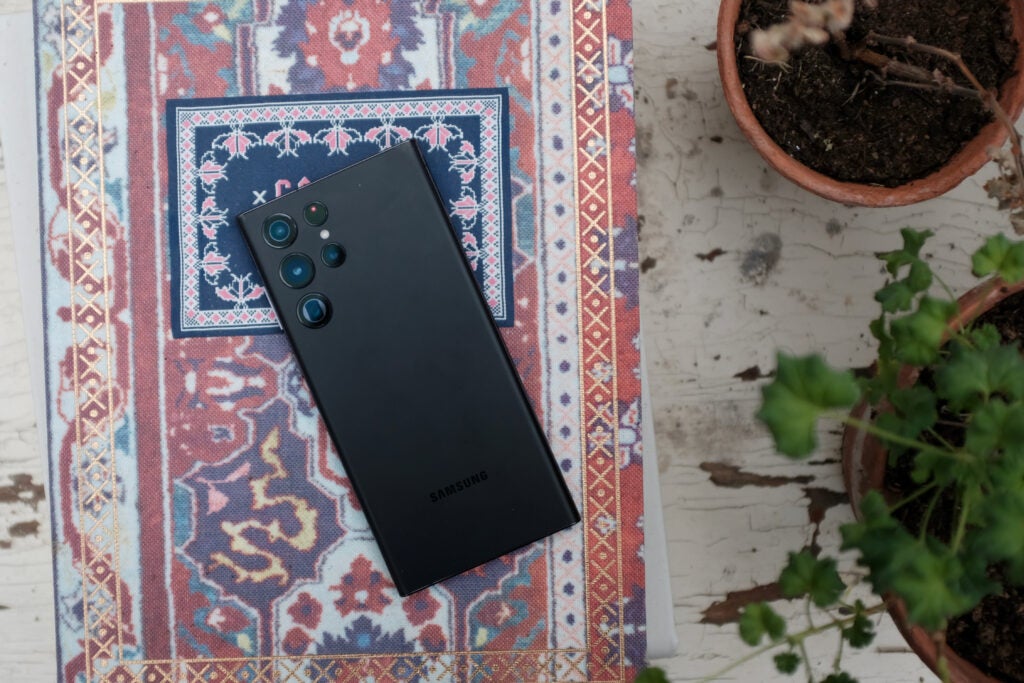
It is basically a refinement of the last Galaxy Note phone rather than an evolution of the design I loved on the Galaxy S21 Ultra. If you appreciated the DNA of the Note line you’ll love this – but for me, it feels like a step backwards. Everything is a bit too rounded and a bit too boxy.
My feelings softened after using the phone for a few days, but I still haven’t warmed to it as much as I did the S21 Ultra. The only thing I’d say is a true step forward is the new smooth, satin rear as it doesn’t seem to ever pick up grimy fingerprints as much as past Samsung flagships.
The new design for the camera sensors has them sticking out, so the phone rocks a lot when you perch it on a table. I’ve also found dust gets caught around the camera sensors very easily when the phone has been in my pocket for prolonged periods.
It’s a big, heavy and surprisingly wide device – though when you consider everything on offer that’s hardly a surprise. With the S Pen inserted, the phone weighs 229g and really needs to be grasped with two hands to be held comfortably. I am used to big phones – before this I had been using the 240g iPhone 13 Pro Max – but I was still taken aback by the hefty dimensions on offer here.
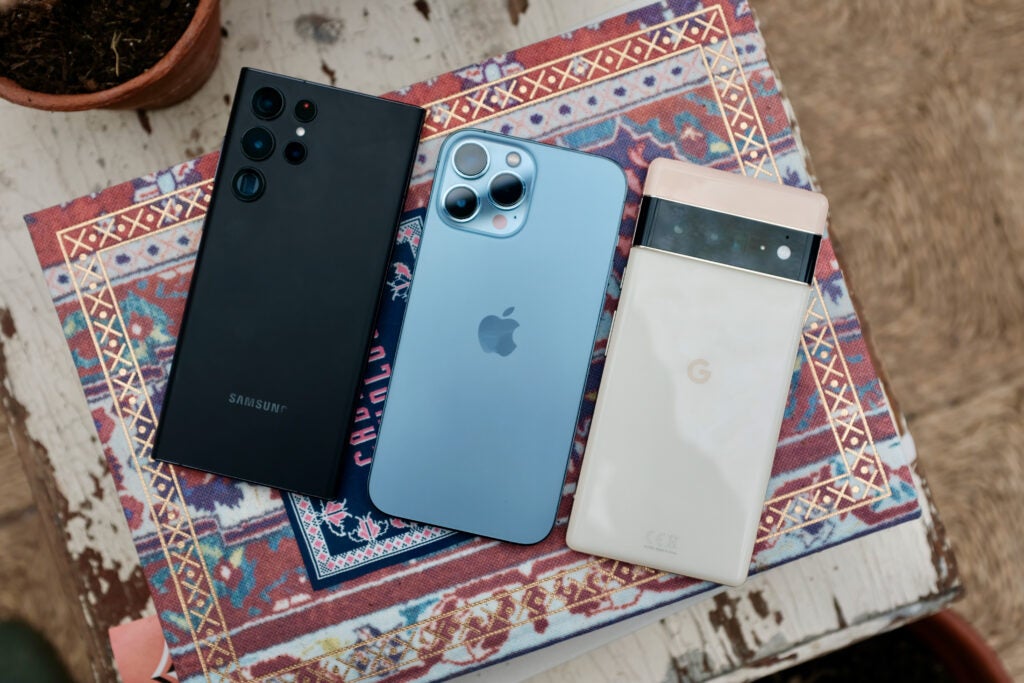
My final build note revolves around the vibration motor. It’s just so… non-existent? I’ve missed dozens of notifications, even phone calls, because I just can’t feel the haptic response. Even when the S22 Ultra is on a desk, the tinny sound the vibration gives off feels like the phone is on the other side of the office. It’s a different story with the general UI haptics though, as the soft vibration when you hit keys is very satisfying.
While I might have some concerns over the look, I am all-in on the display. The 6.8-inch OLED panel packs a 1440p resolution for pin-sharp details and can now ramp all the way down 1Hz to save battery life.
Open up a game or start scrolling Twitter and that refresh rate jumps to 120Hz – and it really does look super smooth. Samsung has also added a 240hz sampling rate into the Game Mode, ideal for titles like online shooters and brawlers that require the fastest response possible.
To my eyes, the screen looks like one of, if not the, best around. Colours pop without feeling lurid and detail is simply unmatched. I loaded up Our Planet in HDR on Netflix and the colourful scenery looked stunning. I was immersed, which is saying a lot considering this kind of content is usually best consumed on a whopping great big TV.
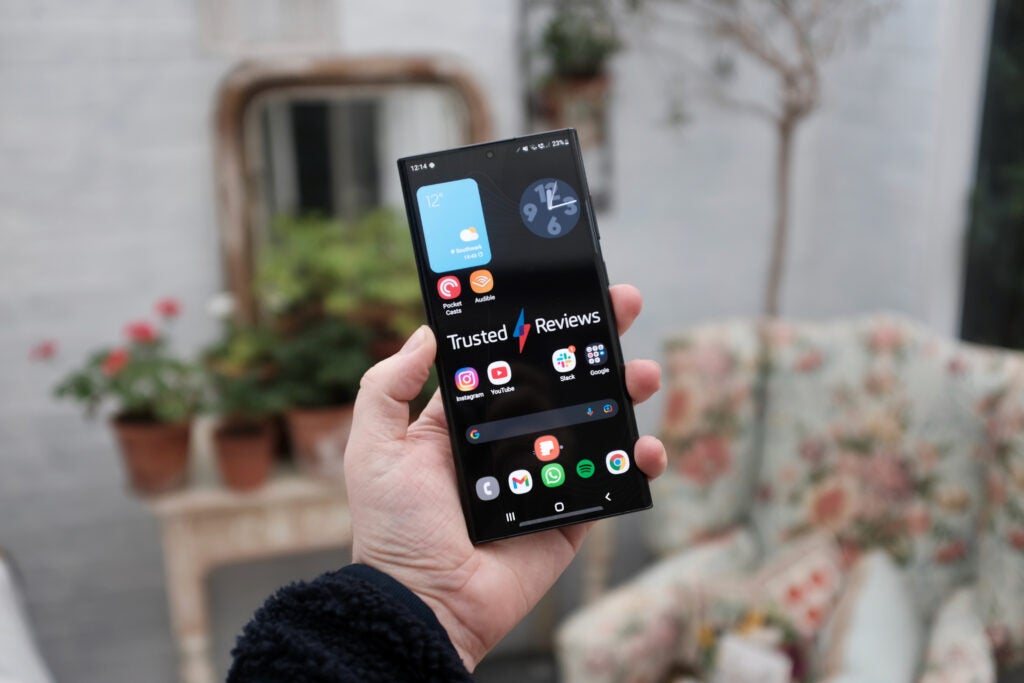
Aside from looking vivid and bright, the Dynamic OLED screen has a new feature called Vision Booster. Samsung says this pushes up detail and contrast in brighter situations, making it easier to see video content. This is certainly an interesting addition for those who watch a lot of Netflix shows in sunny environments, though considering it’s very dreary here in the UK it’s not something I could utilise much.
Brightness is another item key to Samsung’s hype for this phone, and it deserves the build-up. While the top 1750 nits brightness will likely only be hit in specific HDR situations, you do have a lot of control over the levels of brightness. I could easily hit 770 nits in the Extra Bright mode, which is a very high number you’ll only need sparingly.
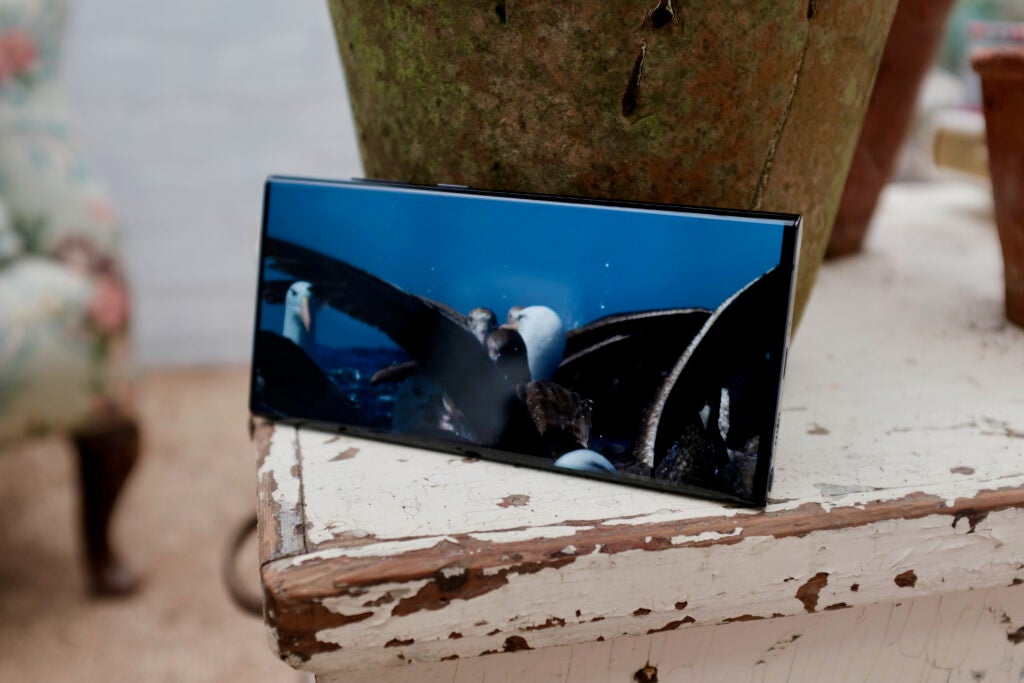
In terms of colour, there are two modes. I found the Vivid mode to be the most accurate (97.4% DCI-P3, 99.8% sRGB), though there’s a natural option too if you prefer colours a little more muted.
The screen is made to work with the S Pen, which is now included with the phone and slots away in a silo next to the USB-C port when not in use. Latency has been reduced from 9ms to 2.8ms for more natural writing, and Samsung claims the software uses AI skills to predict what you’ll write next.
The S Pen felt as good as it did on previous Note phones and it’s very responsive. I tried but it’s virtually impossible to spot any lag between the pen touching the display and the ink appearing. Popping it out and jotting down a shopping list or quick to-do list remains fast and natural. For those that loved the S Pen, you’ll still love it here.
I am not convinced whether this phone needs an S Pen, though – but considering the love that little bit of plastic tends to receive I am sure many of you will disagree. The Note was always a niche device, appreciated by those who wanted a stylus. The S22 Ultra is meant to be Samsung’s true flagship phone for the consumer who wants the best screen and best camera – I just don’t think most want an S Pen too. But, if you don’t want to use it it’s fairly easy to forget about and it doesn’t seem like much was sacrificed to include it.
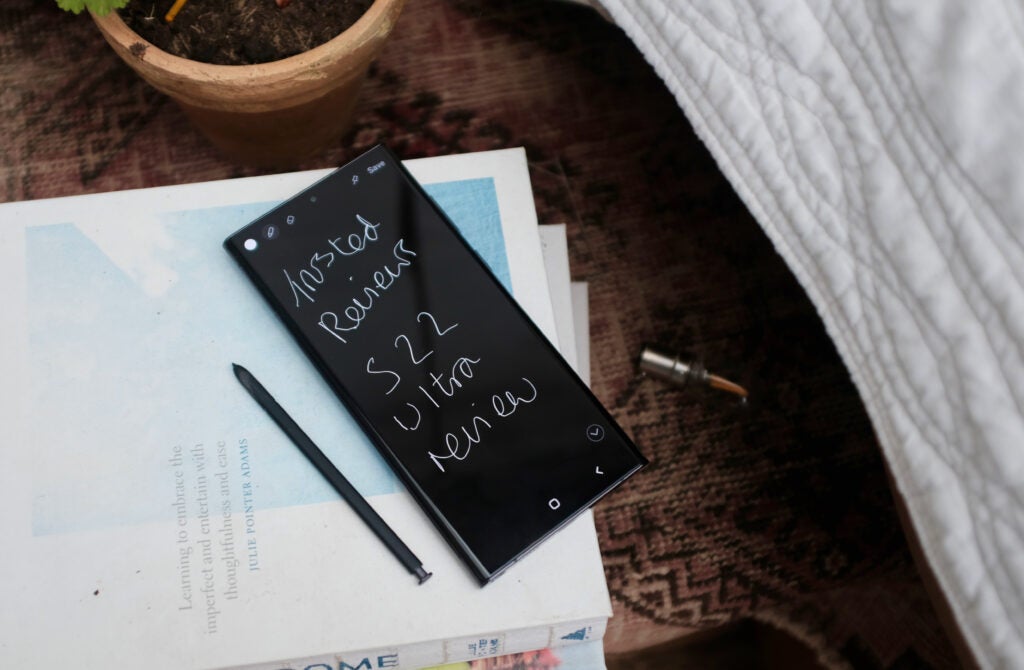
Samsung seems to be focussing a lot on making the whole S22 range more eco-conscious. It has shrunk down the size of the boxes compared to its predecessors, removed all plastic and committed to using recycled fishing nets in certain parts of the device.
Camera
- Big focus on AI in all areas of the camera
- Four cameras on the back
- Expert RAW app for granular control
The camera setup is certainly the star of the Galaxy S22 Ultra, and Samsung clearly wants to rival other 2022 flagships for the title of the best camera phone, and it still holds up well in 2023. Samsung has done a very good job; the camera is brilliantly versatile, easily surpassing Apple and Google for zoom skills.
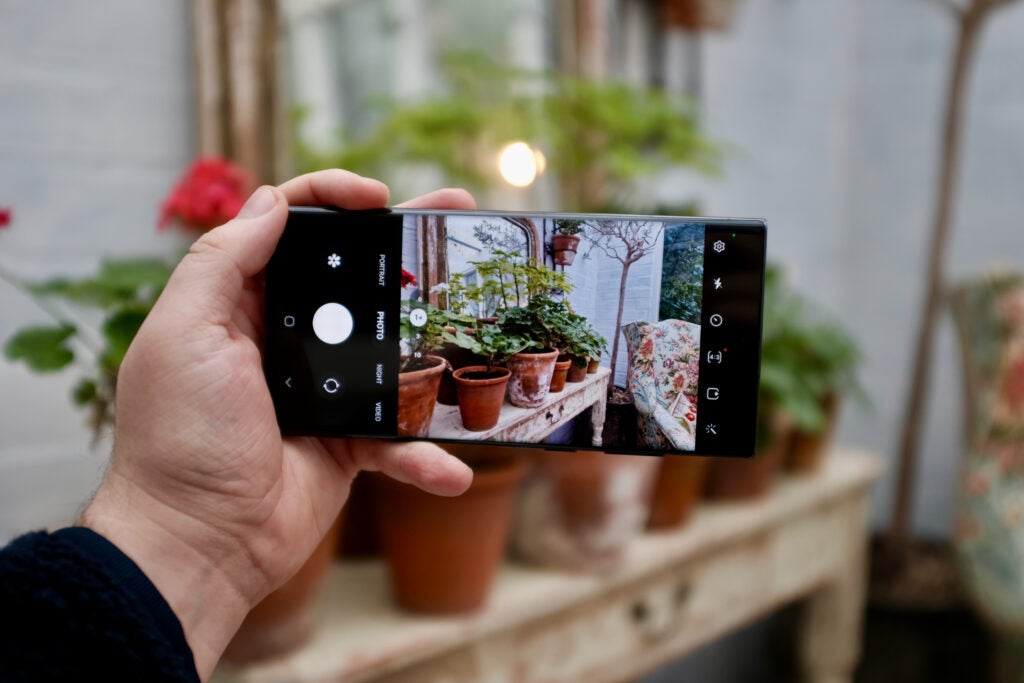
While it’s far from always about the actual tech on offer, Samsung is king when it comes to packing in megapixels and other high-end camera equipment into its phones. For instance, the S22 Ultra uses a 108-megapixel sensor on the back with an f/1.8 lens, Dual Pixel focussing and OIS, though that has been usurped by the even bigger 200-megapixel sensor on the newer S23 Ultra.
Pictures from the main rear camera are good, though not a huge leap in quality from the S21 Ultra. Considering that was, and remains, one of the best camera phones around this isn’t a huge issue. Colours are rich and vibrant and detail is pin-sharp – I would even say certain shots can look a little too sharp, especially street photography where there are various details battling for your attention.
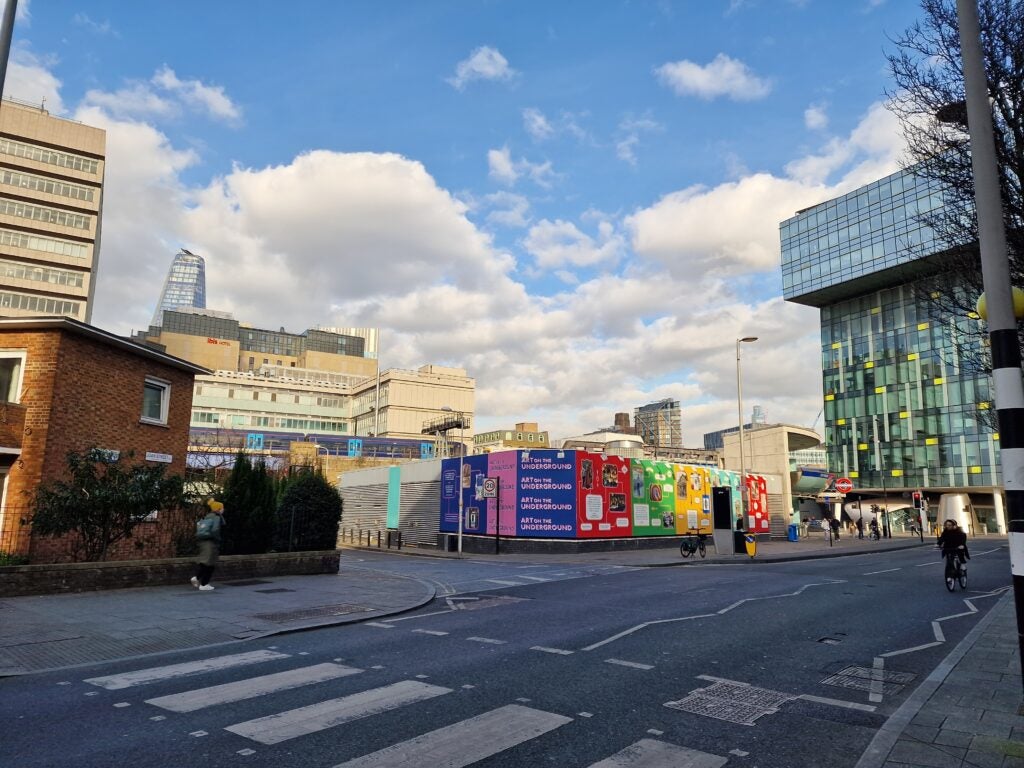
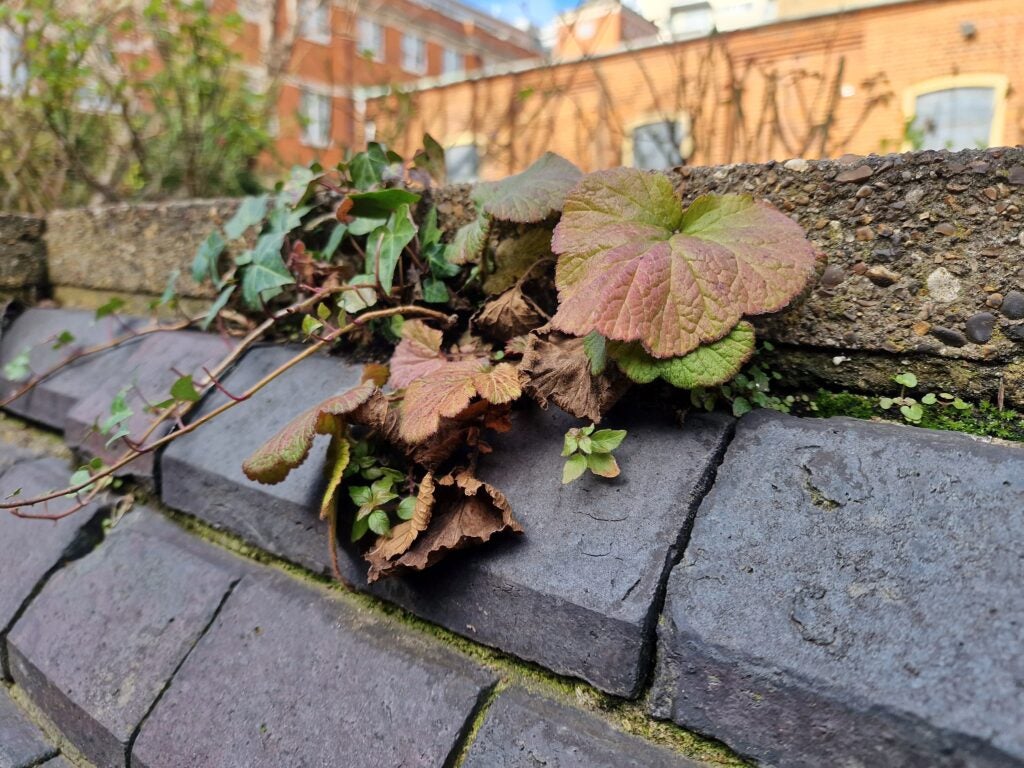
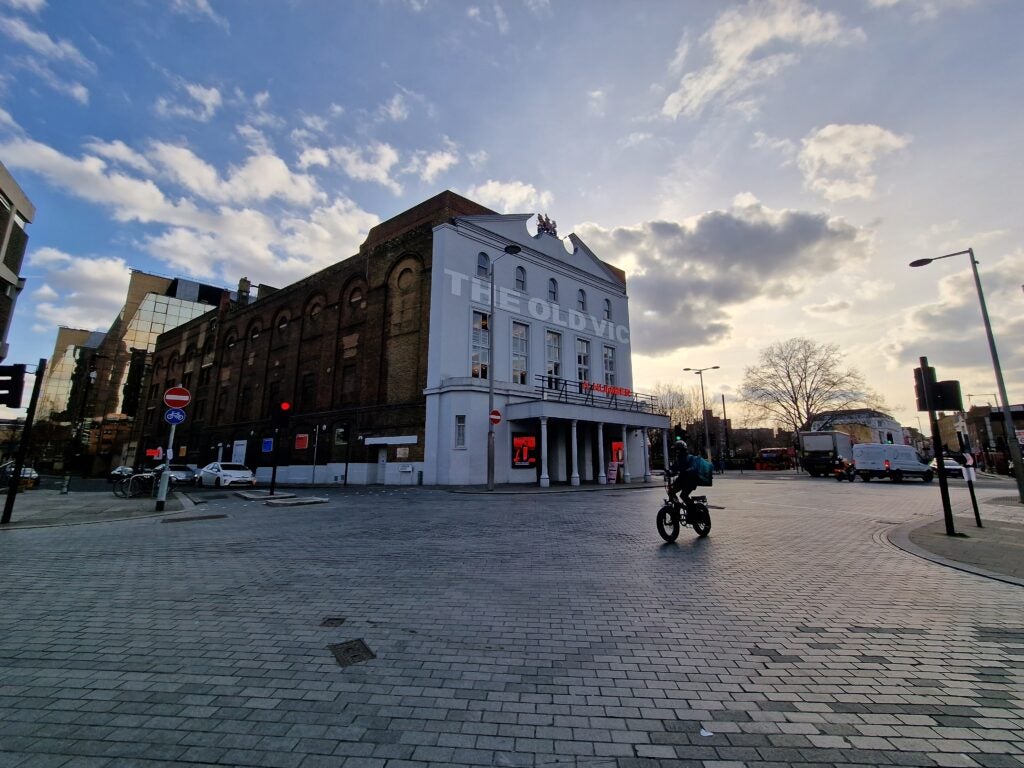
By default, it’ll combine multiple pixels from that 108MP sensor together, though you can shoot at full-res if you want.
Next to this, there’s a 12MP ultra wide (f/2.2, 120-degree field of view) and a duo of 10-megapixel telephoto cameras. One of these packs 3x optical zoom, while the other ups it to 10x. If that’s not enough zoom, the Space Zoom feature returns, allowing up to 100x Digital Zoom with the help of some AI Super Resolution Tech.
Zooming is where the S22 Ultra impresses. The capabilities on offer easily beat the competition from Apple and Google. I’m not talking about hitting 100x – these shots still look grainy and generally are a mess – but at 10x and below the results are fantastic. I stood outside Trusted Reviews HQ and zoomed 10x towards the tip of The Shard and the resulting images are crisp and perfectly usable.
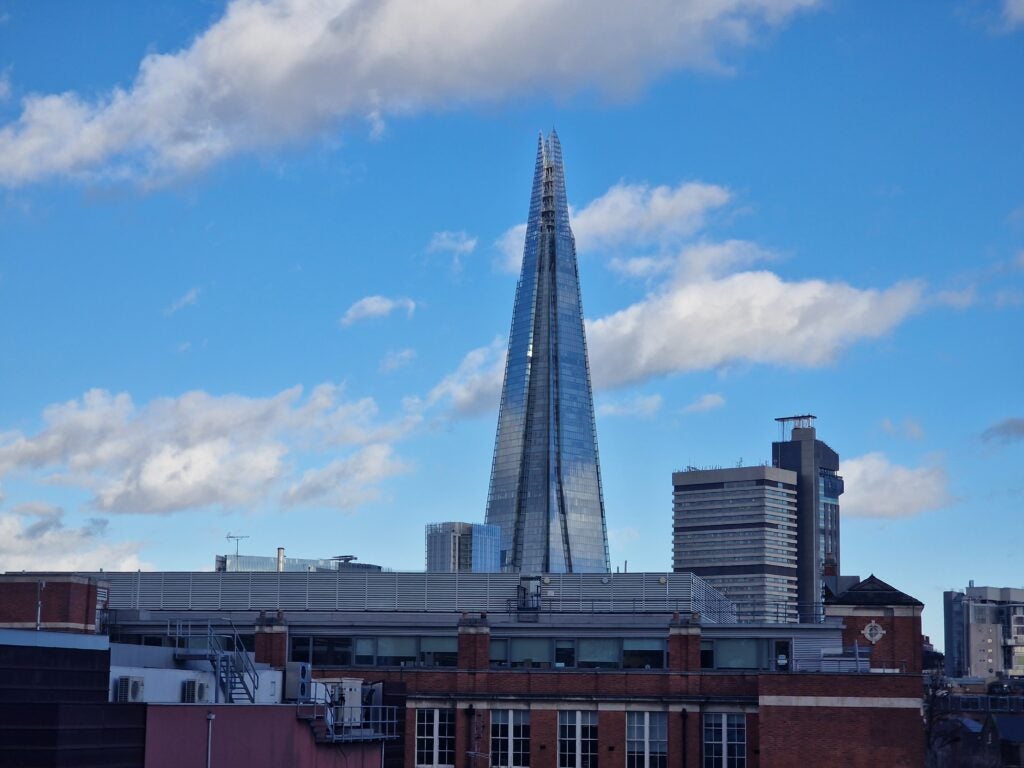

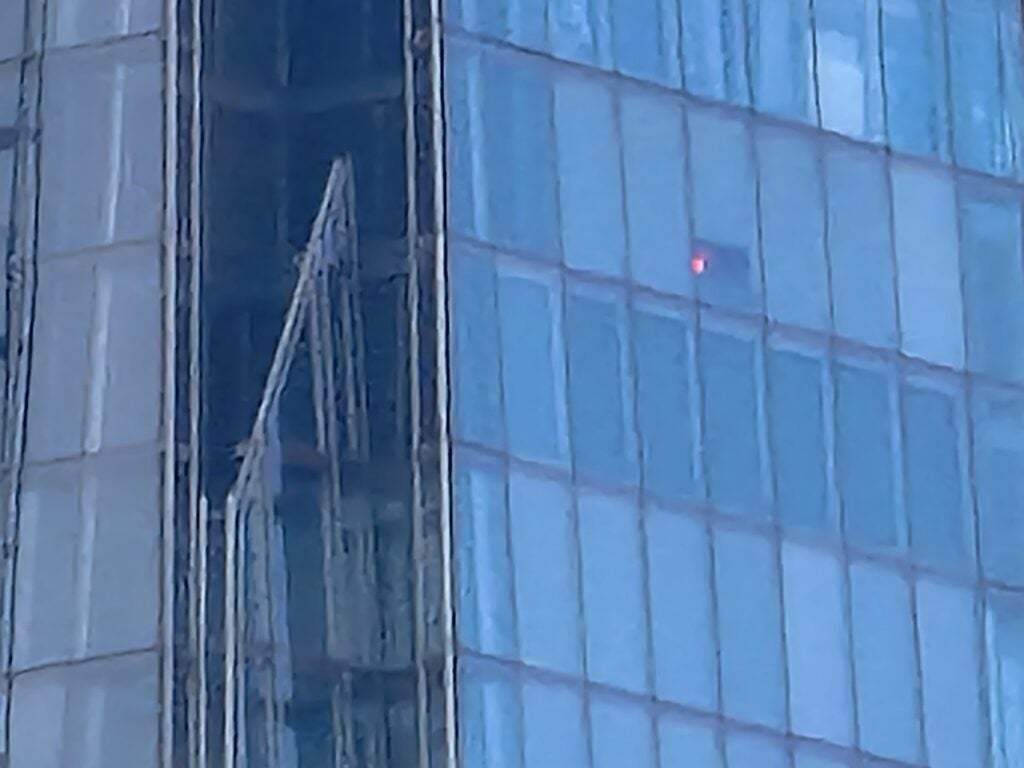
Around the front, there’s a 40-megapixel selfie camera that captures nice snaps with good skin tones and not too much overbearing sharpening or smoothing.
The theme of AI runs through a lot of what Samsung is doing with the camera here. It uses artificial intelligence in night photography to steady the camera when you’re shooting video. The tech worked great during testing, offering me very impressive and stable results; automatically switching the frame rate and altering the strength of the bokeh blur in portrait mode as the situation required.
Auto frame snaps is another AI focussed feature. It’s designed to shift the focus and zoom to fit more (or less) faces into your shots depending on the environment the camera’s in. This feels like a good way to make sure people utilise all the available cameras, without making them manually pick between them.
It’s easy to spot the AI kicking into gear and it can lead to very obvious changes in lens and colour tone that can be quite jarring. I was taking pictures of my dog Peach in lower-light and the camera kept automatically switching between regular and night modes, drastically altering the colours each time. This is less obvious when it’s very dark and the camera knows the surroundings a little better.

Night photography is a big focus with the camera. Samsung says the pixels inside the 108-megapixel sensor are 1.23x larger than those in the S21 Ultra, allowing more light into the sensor. Again, the use of AI makes itself known, upping detail and reducing noise.
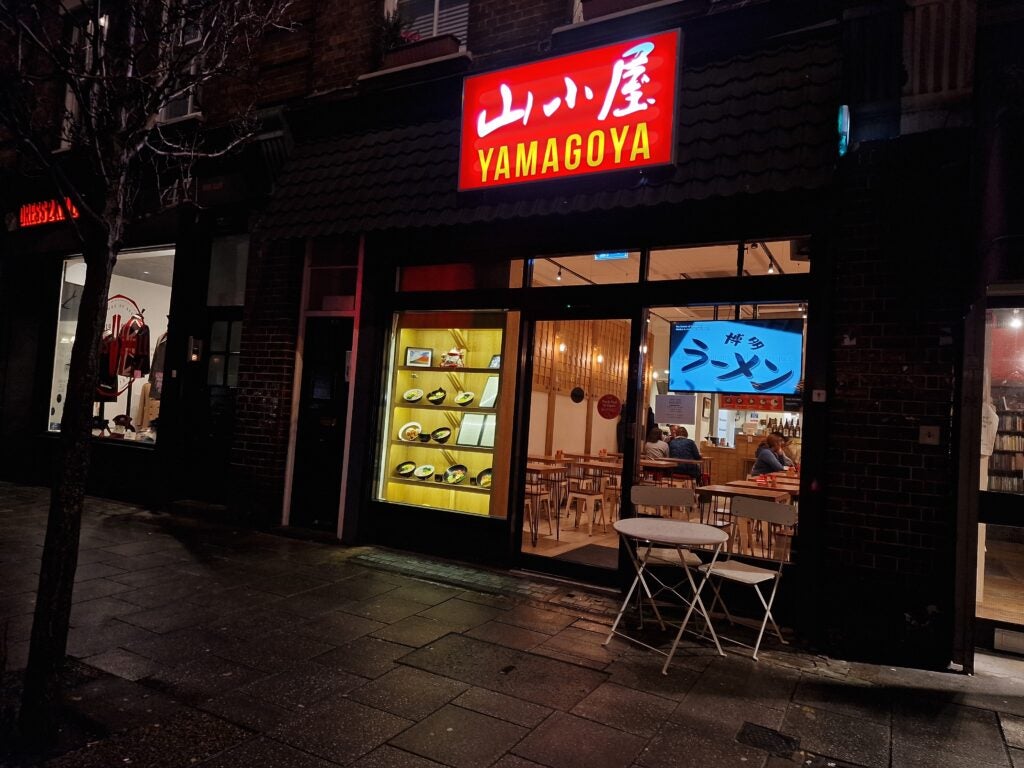
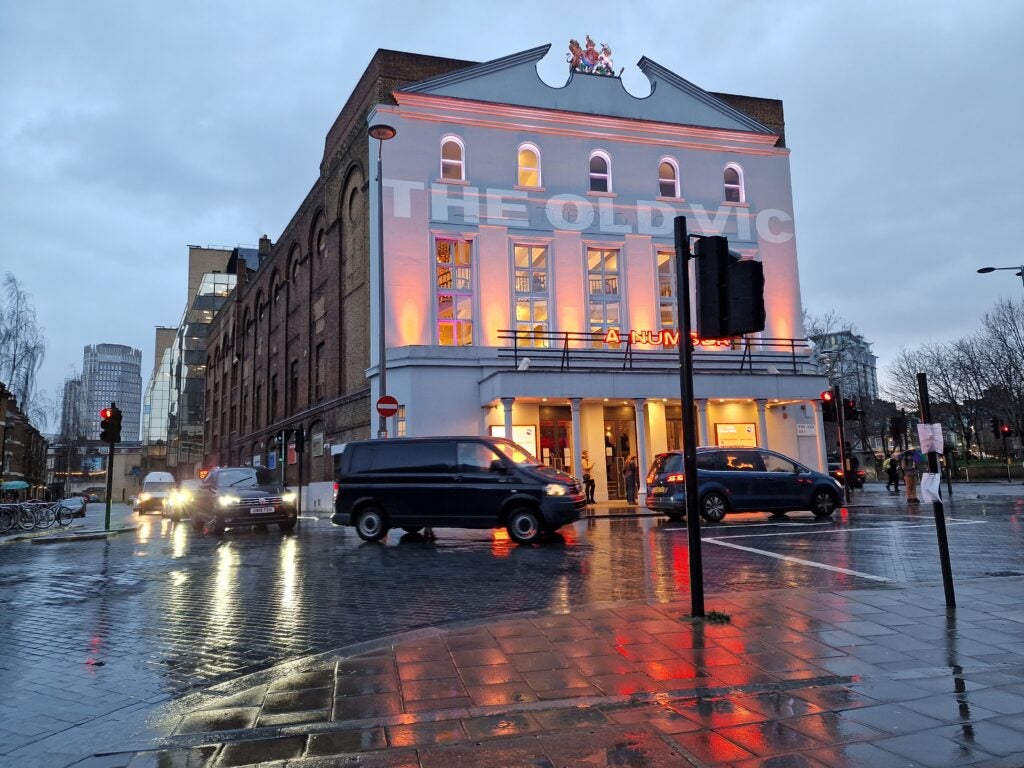
Throughout my time with the phone, I have found the low-light and night shooting to be arguably the biggest camera upgrade over the Galaxy S21 Ultra. The phone does a wonderful job at both retaining details in tough conditions and ensuring that snaps that deserve to be inky dark are so.
It’s worth noting that performance is even better on the newer S23 Ultra, utilising 16-in-1 pixel binning tech to capture even more light, detail and colour than the S22 Ultra. If low-light photography is a focus for you, it might be worth opting for the newer model.
Samsung is bringing more focus to its previously-announced Expert RAW app. Similar to the Pro app on Sony’s Xperia I flagship, this is a separate camera app that gives you far more granular control and the ability to shoot in the RAW format. RAW, unlike the JPEG format phones typically shoot in, is uncompressed and allows keen editors to wrangle a better final product out of an initial image. Unless you plan on spending time tweaking an image afterwards in an app like Lightroom, you‘re not really going to see the true benefit of RAW.
I’m not quite sure why this stuff, including control over white balance and ISO, can’t be built smartly into the main camera app – but maybe Samsung wants to keep that as simple as possible.
Performance
- Choice of chipset depends on region
- Up to 12GB RAM and 1TB storage
- Modest upgrades over the Galaxy S21
The chipset sitting at the heart of the Samsung Galaxy S22 Ultra will vary depending on the region. US buyers, for instance, get the Snapdragon 8 Gen 1 chip from Qualcomm whereas those in the UK get the Exynos 2200 variant. Both chipsets are built upon the 4nm architecture, meaning they should be more efficient than the outgoing 5nm models.
Interesting side-note: that was the last time Samsung split the processors, with the newer S23 Ultra sporting a custom Snapdragon 8 Gen 2 for Galaxy worldwide.
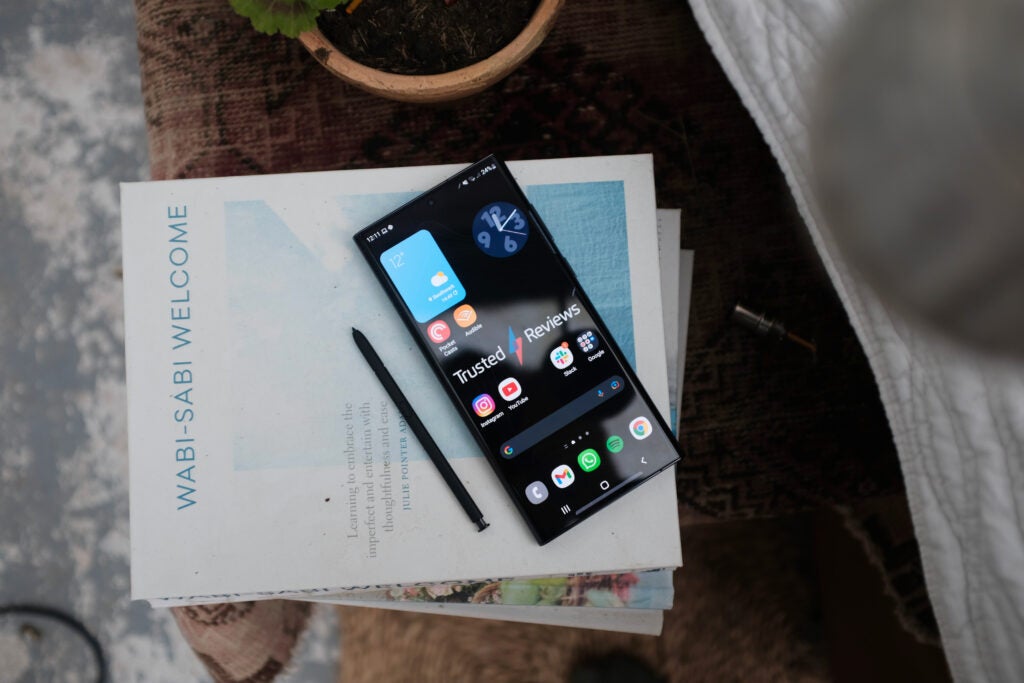
RAM options range from 8GB to 12GB, while storage ranges from 128GB to 1TB. The base RAM level is a little lower than the S21 Ultra, but Samsung says this is negated by improved virtual RAM options. My review sample is the 12GB/256GB Exynos model, so I can’t comment on the performance of the 8GB RAM variant or the Snapdragon 8 Gen 1 model.
As you’d expect there’s 5G support, plus Wi-Fi 6 and 6E connectivity for those with a supported router and UWB for devices that work with ultra wideband such as Samsung’s Smart Tag. Samsung is great at using the latest tech and standards and that’s very much at play here.
That’s the specs part out of the way, but how does the Galaxy S22 Ultra actually perform? For the most part, the updated chip offers a small upgrade over the outgoing Exynos chip.
There are slight improvements in the scores achieved in synthetic benchmarks like Geekbench 5 and Antutu and a more notable bump in 3D Mark’s GPU tests. More importantly, the S22 Ultra stays cooler in these tests and seems to be able to push performance for a sustained period without any throttling. This will be great news for those who put constant hours into demanding titles like Genshin Impact.
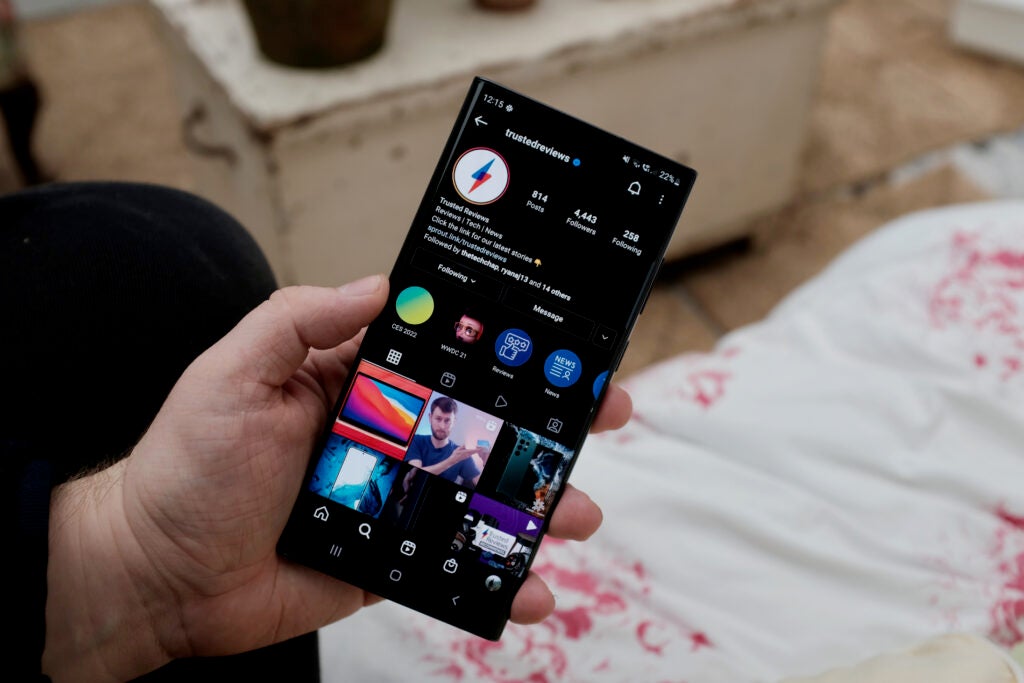
With real-world use, the Galaxy S22 Ultra feels fast. It can, predictably, handle games with ease and hit high settings without getting too hot. But I have run into a few software-based bugs throughout my time with the phone. Apps often force quit, there’s a small but noticeable lag when hitting the camera shutter button, and frequently I get a black screen when unlocking the phone. Hopefully these bugs get squashed quickly.
Call quality and Wi-Fi performance are both good but speakers aren’t as rich as those on the iPhone 13 Pro Max. There remains no expandable storage, so choose wisely when you purchase.
Samsung’s One UI (based on Android 12) is a respectable Android skin. There are some of Android 12’s best features here, including a play on the Material You theming engine. I’m not a huge fan of the aesthetic of One UI though, especially when compared to how slick Android now looks on a Pixel 6 Pro. The design just feels a bit basic without any real flair. Your opinion might vary though, and this really doesn’t have any effect on how the software works.
One UI is packed with features and it ticks a lot of boxes. The battery saver modes are excellent, you have a lot of control over performance and the updated Notes app adds in support for more language for its handwriting recognition.
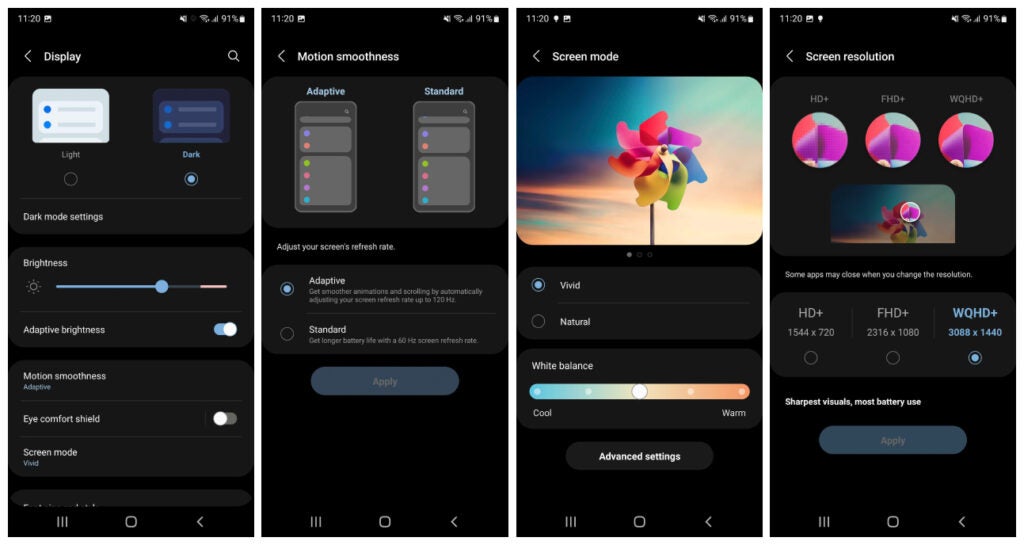
What’s more important though is that Samsung is seriously supporting this phone when it comes to updates. There’s a promise of five years of updates and four major OS updates – that means the S22 Ultra will still be supported when Android 16 rolls around. Considering how many big Android phones only get two major OS updates, this is huge news and shows that investment should last for a number of years.
Samsung Galaxy S22 Ultra vs S21 Ultra: how do the specs compare?
Battery Life
- 5000mAh battery
- No charger included
- Can get a full charge in around an hour
I mentioned concerns about battery capacity in my hands-on with the Galaxy S22, but I didn’t have the same qualms here and I have generally found the endurance on par with Galaxy S21 Ultra. This is to say it’s good, but not exactly groundbreaking.
Inside the S22 Ultra there’s a 5000mAh cell, which is paired with an efficient screen and 4nm chipset for good battery life. It doesn’t last anywhere near as long as the iPhone 13 Pro Max though and throughout my week with the phone, I have been charging it on a nightly basis after hitting the red zone just before bed. Granted, I have been pushing the display’s brightness and keeping the 1440p setting enabled. Lower these and you can stretch it further.
There are a number of other battery saver modes too, each with a vast array of customisations like throttling performance, turning off 5G and automatically lowering the screen resolution. Play around with these and you’ll find the best mix of performance and longevity to suit your needs.
Where the extra efficiency is most noticeable is with tasks that keep the screen on. I streamed an hour of Netflix in HDR at about 90% brightness, and it drained 10%. Drop the brightness to 60% (which remains very bright) and it took off just 6%. That’s impressive stuff and shows how important these adaptive screens can be.
There’s no charger supplied, though the Galaxy S22 Ultra can fast charge with both 25w and 45w plugs. I don’t have a dedicated Samsung charger, so for this review I used a standard Anker multi-port plug that supports the 45w standard. Using the included USB-C cable I was impressed with the speeds. A quick five-minute charge gave me 10%, while I hit 25% in 11 minutes. 25 minutes got me past 50% and I consistently hit 100% in around an hour.
15w Qi wireless is supported too, as is Wireless Powershare for charging up other devices like watches and earbuds wirelessly. 15w is fairly slow compared to wireless charging speeds achieved by devices like the OnePlus 10 Pro and it remains a slow and inefficient way to juice up. Still, it’s better to have it than not.
Latest deals
Should you buy it?
You don’t want sacrifices: This is a phone that packs everything possible. From the display to the camera and the internals this is a big phone for those who want all the features possible.
You’re concerned about size: This phone is big and it takes a strong grasp to comfortably hold it.
Final Thoughts
If you’ve been lamenting Samsung’s decision to kill the Note series then the Samsung Galaxy S22 Ultra is well and truly its spiritual successor, and with the release of the S23 Ultra, it’s cheaper than ever.
While I am a little disappointed about the change in design, it’s hard not to marvel at everything going on here – there aren’t any sacrifices made here. The screen is a technical marvel, the camera is seriously versatile and the software feature packed. There’s even an S Pen crammed in.
The internals might not represent huge year-on-year improvements and the camera system has quirks in the way it uses AI, but if you’re after a true powerhouse and one of the best Android phones you won’t be disappointed.
How we test
We test every mobile phone we review thoroughly. We use industry standard tests to compare features properly and we use the phone as our main device over the review period. We’ll always tell you what we find and we never, ever, accept money to review a product.
Used as main phone for eight days
Tested the camera in various surroundings
Mixture of benchmarks and real-world use
FAQs
No, the S Pen is included with the S22 Ultra – just like the Note series.
There is no expandable storage here. But, you can choose between 128, 256, 512GB and 1TB options.
Samsung is saying you’ll get five years of updates, including four years of major OS updates.
Trusted Reviews test data
We run all the phones we review through certain tests to go alongside the real-world data.
Geekbench 5 single core
Geekbench 5 multi core
sRGB
Adobe RGB
DCI-P3
Max brightness
1 hour video playback (Netflix, HDR)
30 minute gaming (intensive)
30 minute gaming (light)
1 hour music streaming (online)
1 hour music streaming (offline)
Time from 0-100% charge
Time from 0-50% charge
3D Mark – Wild Life
3D Mark – Wild Life Stress Test
3D Mark – Sling Shot Extreme
Full specs
Here are all the most important specs for the Samsung Galaxy S22 Ultra.
Jargon buster
mAh
An abbreviation for milliampere-hour and a way to express the capacity of batteries, especially smaller ones in phones. In most cases the higher the mAh, the longer the battery will last but this isn’t always the case.
5G
Offering faster download and upload speeds when compared to 4G. Great for game streaming and HDR video playback. Not supported everywhere yet and speeds vary wildly.
Qi Wireless Charging
The most common format for wireless charging and the one supported by the majority of devices. Charge speeds vary a lot by the phone.
Verdict
It may be a year old, but the Samsung Galaxy S22 Ultra is still a tempting phone with impressive capabilities in a rather large package. Most of it still works fantastically well, and importantly, it’s dropped in price since the release of the S23 Ultra.
Pros
- Stunning display with fantastic detail and brightness
- Versatile camera system with impressive zoom
- Good low-light camera performance
- Fast charging
- Promise of many years of updates
Cons
- Battery life should be better
- Design a step backward
- You need to buy the fast charger separately
Availability
- UKRRP: £1149
- USARRP: $1199.99
- EuropeRRP: €1259
-
Huge displayMassive 6.8-inch display with a 1440p resolution and seriously high brightness levels -
High-end specsExynos 2200, up to 12GB and 1TB storage -
S Pen includedThere’s an S Pen stylus included and it fits inside the phone
Introduction
The Galaxy S22 Ultra is the top handset in Samsung’s 2022 flagship range, but this phone could have very easily been called the Galaxy S22 Note.
After canning the cult-favourite Note series a few years ago, Samsung has been trying various ways of adding a few of the series’ best traits into its other phones.
The Galaxy S21 Ultra, for example, was the first device not designated a Note to support the sort-of-handy S Pen stylus – even if it was an additional accessory that didn’t live in the phone itself.
With the Galaxy S22 Ultra, Samsung has gone in another direction – and not one I can say I was expecting. The Galaxy S22 Ultra is basically just a next-gen Galaxy Note. It looks like a Note, has a slot for the S Pen like a Note and carries across many of the features most would associate with a Note.
This is also the top-end model of the Galaxy S22 range and that is reflected in its price. The base model, with 128GB storage and 8GB RAM, has an RRP of £1149. An extra £100 gets you 256GB of storage and 12GB RAM. For £1329, storage rises to 512GB and for £1499, it rises again to 1TB.
However, it’s worth noting that it can be found much cheaper in 2023, especially now that the newer Samsung Galaxy S23 Ultra is available, making it much more tempting than it was at release in 2022. If you’re curious about the differences, take a look at our Samsung Galaxy S23 Ultra vs Galaxy S22 Ultra comparison.
Screen and Design
- The biggest phone in the Galaxy S22 range
- Also has the most advanced display
- Available in multiple colours, including a sleek burgundy
As the Ultra moniker implies, the Samsung Galaxy S22 Ultra is the biggest, heaviest and most feature-rich member of the S22 family. It has a 6.8-inch display (larger than the 6.6-inch screen on the Plus), a silo for the S Pen to dock and a stacked camera array on the back.
It also, predictably, picks up some of the highlights of the Galaxy S22’s design, including Armour Aluminium around the sides, Gorilla Glass Victus+ on the front and back (Samsung says this is 12.5% tougher than the previous Victus) and, of course, an IP68 rating.
Samsung has done something quite strange with the overall look of this phone. While the S21, S21 Plus and S21 Ultra had a vaguely similar design, each with a camera module blended into the phone’s design, the Galaxy S22 Ultra looks wildly different to the S22. It’s heavily rounded on the sides, with a non-existent camera module that allows the multitude of sensors to just sit by themselves.

It is basically a refinement of the last Galaxy Note phone rather than an evolution of the design I loved on the Galaxy S21 Ultra. If you appreciated the DNA of the Note line you’ll love this – but for me, it feels like a step backwards. Everything is a bit too rounded and a bit too boxy.
My feelings softened after using the phone for a few days, but I still haven’t warmed to it as much as I did the S21 Ultra. The only thing I’d say is a true step forward is the new smooth, satin rear as it doesn’t seem to ever pick up grimy fingerprints as much as past Samsung flagships.
The new design for the camera sensors has them sticking out, so the phone rocks a lot when you perch it on a table. I’ve also found dust gets caught around the camera sensors very easily when the phone has been in my pocket for prolonged periods.
It’s a big, heavy and surprisingly wide device – though when you consider everything on offer that’s hardly a surprise. With the S Pen inserted, the phone weighs 229g and really needs to be grasped with two hands to be held comfortably. I am used to big phones – before this I had been using the 240g iPhone 13 Pro Max – but I was still taken aback by the hefty dimensions on offer here.

My final build note revolves around the vibration motor. It’s just so… non-existent? I’ve missed dozens of notifications, even phone calls, because I just can’t feel the haptic response. Even when the S22 Ultra is on a desk, the tinny sound the vibration gives off feels like the phone is on the other side of the office. It’s a different story with the general UI haptics though, as the soft vibration when you hit keys is very satisfying.
While I might have some concerns over the look, I am all-in on the display. The 6.8-inch OLED panel packs a 1440p resolution for pin-sharp details and can now ramp all the way down 1Hz to save battery life.
Open up a game or start scrolling Twitter and that refresh rate jumps to 120Hz – and it really does look super smooth. Samsung has also added a 240hz sampling rate into the Game Mode, ideal for titles like online shooters and brawlers that require the fastest response possible.
To my eyes, the screen looks like one of, if not the, best around. Colours pop without feeling lurid and detail is simply unmatched. I loaded up Our Planet in HDR on Netflix and the colourful scenery looked stunning. I was immersed, which is saying a lot considering this kind of content is usually best consumed on a whopping great big TV.

Aside from looking vivid and bright, the Dynamic OLED screen has a new feature called Vision Booster. Samsung says this pushes up detail and contrast in brighter situations, making it easier to see video content. This is certainly an interesting addition for those who watch a lot of Netflix shows in sunny environments, though considering it’s very dreary here in the UK it’s not something I could utilise much.
Brightness is another item key to Samsung’s hype for this phone, and it deserves the build-up. While the top 1750 nits brightness will likely only be hit in specific HDR situations, you do have a lot of control over the levels of brightness. I could easily hit 770 nits in the Extra Bright mode, which is a very high number you’ll only need sparingly.

In terms of colour, there are two modes. I found the Vivid mode to be the most accurate (97.4% DCI-P3, 99.8% sRGB), though there’s a natural option too if you prefer colours a little more muted.
The screen is made to work with the S Pen, which is now included with the phone and slots away in a silo next to the USB-C port when not in use. Latency has been reduced from 9ms to 2.8ms for more natural writing, and Samsung claims the software uses AI skills to predict what you’ll write next.
The S Pen felt as good as it did on previous Note phones and it’s very responsive. I tried but it’s virtually impossible to spot any lag between the pen touching the display and the ink appearing. Popping it out and jotting down a shopping list or quick to-do list remains fast and natural. For those that loved the S Pen, you’ll still love it here.
I am not convinced whether this phone needs an S Pen, though – but considering the love that little bit of plastic tends to receive I am sure many of you will disagree. The Note was always a niche device, appreciated by those who wanted a stylus. The S22 Ultra is meant to be Samsung’s true flagship phone for the consumer who wants the best screen and best camera – I just don’t think most want an S Pen too. But, if you don’t want to use it it’s fairly easy to forget about and it doesn’t seem like much was sacrificed to include it.

Samsung seems to be focussing a lot on making the whole S22 range more eco-conscious. It has shrunk down the size of the boxes compared to its predecessors, removed all plastic and committed to using recycled fishing nets in certain parts of the device.
Camera
- Big focus on AI in all areas of the camera
- Four cameras on the back
- Expert RAW app for granular control
The camera setup is certainly the star of the Galaxy S22 Ultra, and Samsung clearly wants to rival other 2022 flagships for the title of the best camera phone, and it still holds up well in 2023. Samsung has done a very good job; the camera is brilliantly versatile, easily surpassing Apple and Google for zoom skills.

While it’s far from always about the actual tech on offer, Samsung is king when it comes to packing in megapixels and other high-end camera equipment into its phones. For instance, the S22 Ultra uses a 108-megapixel sensor on the back with an f/1.8 lens, Dual Pixel focussing and OIS, though that has been usurped by the even bigger 200-megapixel sensor on the newer S23 Ultra.
Pictures from the main rear camera are good, though not a huge leap in quality from the S21 Ultra. Considering that was, and remains, one of the best camera phones around this isn’t a huge issue. Colours are rich and vibrant and detail is pin-sharp – I would even say certain shots can look a little too sharp, especially street photography where there are various details battling for your attention.



By default, it’ll combine multiple pixels from that 108MP sensor together, though you can shoot at full-res if you want.
Next to this, there’s a 12MP ultra wide (f/2.2, 120-degree field of view) and a duo of 10-megapixel telephoto cameras. One of these packs 3x optical zoom, while the other ups it to 10x. If that’s not enough zoom, the Space Zoom feature returns, allowing up to 100x Digital Zoom with the help of some AI Super Resolution Tech.
Zooming is where the S22 Ultra impresses. The capabilities on offer easily beat the competition from Apple and Google. I’m not talking about hitting 100x – these shots still look grainy and generally are a mess – but at 10x and below the results are fantastic. I stood outside Trusted Reviews HQ and zoomed 10x towards the tip of The Shard and the resulting images are crisp and perfectly usable.



Around the front, there’s a 40-megapixel selfie camera that captures nice snaps with good skin tones and not too much overbearing sharpening or smoothing.
The theme of AI runs through a lot of what Samsung is doing with the camera here. It uses artificial intelligence in night photography to steady the camera when you’re shooting video. The tech worked great during testing, offering me very impressive and stable results; automatically switching the frame rate and altering the strength of the bokeh blur in portrait mode as the situation required.
Auto frame snaps is another AI focussed feature. It’s designed to shift the focus and zoom to fit more (or less) faces into your shots depending on the environment the camera’s in. This feels like a good way to make sure people utilise all the available cameras, without making them manually pick between them.
It’s easy to spot the AI kicking into gear and it can lead to very obvious changes in lens and colour tone that can be quite jarring. I was taking pictures of my dog Peach in lower-light and the camera kept automatically switching between regular and night modes, drastically altering the colours each time. This is less obvious when it’s very dark and the camera knows the surroundings a little better.

Night photography is a big focus with the camera. Samsung says the pixels inside the 108-megapixel sensor are 1.23x larger than those in the S21 Ultra, allowing more light into the sensor. Again, the use of AI makes itself known, upping detail and reducing noise.


Throughout my time with the phone, I have found the low-light and night shooting to be arguably the biggest camera upgrade over the Galaxy S21 Ultra. The phone does a wonderful job at both retaining details in tough conditions and ensuring that snaps that deserve to be inky dark are so.
It’s worth noting that performance is even better on the newer S23 Ultra, utilising 16-in-1 pixel binning tech to capture even more light, detail and colour than the S22 Ultra. If low-light photography is a focus for you, it might be worth opting for the newer model.
Samsung is bringing more focus to its previously-announced Expert RAW app. Similar to the Pro app on Sony’s Xperia I flagship, this is a separate camera app that gives you far more granular control and the ability to shoot in the RAW format. RAW, unlike the JPEG format phones typically shoot in, is uncompressed and allows keen editors to wrangle a better final product out of an initial image. Unless you plan on spending time tweaking an image afterwards in an app like Lightroom, you‘re not really going to see the true benefit of RAW.
I’m not quite sure why this stuff, including control over white balance and ISO, can’t be built smartly into the main camera app – but maybe Samsung wants to keep that as simple as possible.
Performance
- Choice of chipset depends on region
- Up to 12GB RAM and 1TB storage
- Modest upgrades over the Galaxy S21
The chipset sitting at the heart of the Samsung Galaxy S22 Ultra will vary depending on the region. US buyers, for instance, get the Snapdragon 8 Gen 1 chip from Qualcomm whereas those in the UK get the Exynos 2200 variant. Both chipsets are built upon the 4nm architecture, meaning they should be more efficient than the outgoing 5nm models.
Interesting side-note: that was the last time Samsung split the processors, with the newer S23 Ultra sporting a custom Snapdragon 8 Gen 2 for Galaxy worldwide.

RAM options range from 8GB to 12GB, while storage ranges from 128GB to 1TB. The base RAM level is a little lower than the S21 Ultra, but Samsung says this is negated by improved virtual RAM options. My review sample is the 12GB/256GB Exynos model, so I can’t comment on the performance of the 8GB RAM variant or the Snapdragon 8 Gen 1 model.
As you’d expect there’s 5G support, plus Wi-Fi 6 and 6E connectivity for those with a supported router and UWB for devices that work with ultra wideband such as Samsung’s Smart Tag. Samsung is great at using the latest tech and standards and that’s very much at play here.
That’s the specs part out of the way, but how does the Galaxy S22 Ultra actually perform? For the most part, the updated chip offers a small upgrade over the outgoing Exynos chip.
There are slight improvements in the scores achieved in synthetic benchmarks like Geekbench 5 and Antutu and a more notable bump in 3D Mark’s GPU tests. More importantly, the S22 Ultra stays cooler in these tests and seems to be able to push performance for a sustained period without any throttling. This will be great news for those who put constant hours into demanding titles like Genshin Impact.

With real-world use, the Galaxy S22 Ultra feels fast. It can, predictably, handle games with ease and hit high settings without getting too hot. But I have run into a few software-based bugs throughout my time with the phone. Apps often force quit, there’s a small but noticeable lag when hitting the camera shutter button, and frequently I get a black screen when unlocking the phone. Hopefully these bugs get squashed quickly.
Call quality and Wi-Fi performance are both good but speakers aren’t as rich as those on the iPhone 13 Pro Max. There remains no expandable storage, so choose wisely when you purchase.
Samsung’s One UI (based on Android 12) is a respectable Android skin. There are some of Android 12’s best features here, including a play on the Material You theming engine. I’m not a huge fan of the aesthetic of One UI though, especially when compared to how slick Android now looks on a Pixel 6 Pro. The design just feels a bit basic without any real flair. Your opinion might vary though, and this really doesn’t have any effect on how the software works.
One UI is packed with features and it ticks a lot of boxes. The battery saver modes are excellent, you have a lot of control over performance and the updated Notes app adds in support for more language for its handwriting recognition.

What’s more important though is that Samsung is seriously supporting this phone when it comes to updates. There’s a promise of five years of updates and four major OS updates – that means the S22 Ultra will still be supported when Android 16 rolls around. Considering how many big Android phones only get two major OS updates, this is huge news and shows that investment should last for a number of years.
Samsung Galaxy S22 Ultra vs S21 Ultra: how do the specs compare?
Battery Life
- 5000mAh battery
- No charger included
- Can get a full charge in around an hour
I mentioned concerns about battery capacity in my hands-on with the Galaxy S22, but I didn’t have the same qualms here and I have generally found the endurance on par with Galaxy S21 Ultra. This is to say it’s good, but not exactly groundbreaking.
Inside the S22 Ultra there’s a 5000mAh cell, which is paired with an efficient screen and 4nm chipset for good battery life. It doesn’t last anywhere near as long as the iPhone 13 Pro Max though and throughout my week with the phone, I have been charging it on a nightly basis after hitting the red zone just before bed. Granted, I have been pushing the display’s brightness and keeping the 1440p setting enabled. Lower these and you can stretch it further.
There are a number of other battery saver modes too, each with a vast array of customisations like throttling performance, turning off 5G and automatically lowering the screen resolution. Play around with these and you’ll find the best mix of performance and longevity to suit your needs.
Where the extra efficiency is most noticeable is with tasks that keep the screen on. I streamed an hour of Netflix in HDR at about 90% brightness, and it drained 10%. Drop the brightness to 60% (which remains very bright) and it took off just 6%. That’s impressive stuff and shows how important these adaptive screens can be.
There’s no charger supplied, though the Galaxy S22 Ultra can fast charge with both 25w and 45w plugs. I don’t have a dedicated Samsung charger, so for this review I used a standard Anker multi-port plug that supports the 45w standard. Using the included USB-C cable I was impressed with the speeds. A quick five-minute charge gave me 10%, while I hit 25% in 11 minutes. 25 minutes got me past 50% and I consistently hit 100% in around an hour.
15w Qi wireless is supported too, as is Wireless Powershare for charging up other devices like watches and earbuds wirelessly. 15w is fairly slow compared to wireless charging speeds achieved by devices like the OnePlus 10 Pro and it remains a slow and inefficient way to juice up. Still, it’s better to have it than not.
Latest deals
Should you buy it?
You don’t want sacrifices: This is a phone that packs everything possible. From the display to the camera and the internals this is a big phone for those who want all the features possible.
You’re concerned about size: This phone is big and it takes a strong grasp to comfortably hold it.
Final Thoughts
If you’ve been lamenting Samsung’s decision to kill the Note series then the Samsung Galaxy S22 Ultra is well and truly its spiritual successor, and with the release of the S23 Ultra, it’s cheaper than ever.
While I am a little disappointed about the change in design, it’s hard not to marvel at everything going on here – there aren’t any sacrifices made here. The screen is a technical marvel, the camera is seriously versatile and the software feature packed. There’s even an S Pen crammed in.
The internals might not represent huge year-on-year improvements and the camera system has quirks in the way it uses AI, but if you’re after a true powerhouse and one of the best Android phones you won’t be disappointed.
How we test
We test every mobile phone we review thoroughly. We use industry standard tests to compare features properly and we use the phone as our main device over the review period. We’ll always tell you what we find and we never, ever, accept money to review a product.
Used as main phone for eight days
Tested the camera in various surroundings
Mixture of benchmarks and real-world use
FAQs
No, the S Pen is included with the S22 Ultra – just like the Note series.
There is no expandable storage here. But, you can choose between 128, 256, 512GB and 1TB options.
Samsung is saying you’ll get five years of updates, including four years of major OS updates.
Trusted Reviews test data
We run all the phones we review through certain tests to go alongside the real-world data.
Geekbench 5 single core
Geekbench 5 multi core
sRGB
Adobe RGB
DCI-P3
Max brightness
1 hour video playback (Netflix, HDR)
30 minute gaming (intensive)
30 minute gaming (light)
1 hour music streaming (online)
1 hour music streaming (offline)
Time from 0-100% charge
Time from 0-50% charge
3D Mark – Wild Life
3D Mark – Wild Life Stress Test
3D Mark – Sling Shot Extreme
Full specs
Here are all the most important specs for the Samsung Galaxy S22 Ultra.
Jargon buster
mAh
An abbreviation for milliampere-hour and a way to express the capacity of batteries, especially smaller ones in phones. In most cases the higher the mAh, the longer the battery will last but this isn’t always the case.
5G
Offering faster download and upload speeds when compared to 4G. Great for game streaming and HDR video playback. Not supported everywhere yet and speeds vary wildly.
Qi Wireless Charging
The most common format for wireless charging and the one supported by the majority of devices. Charge speeds vary a lot by the phone.


















